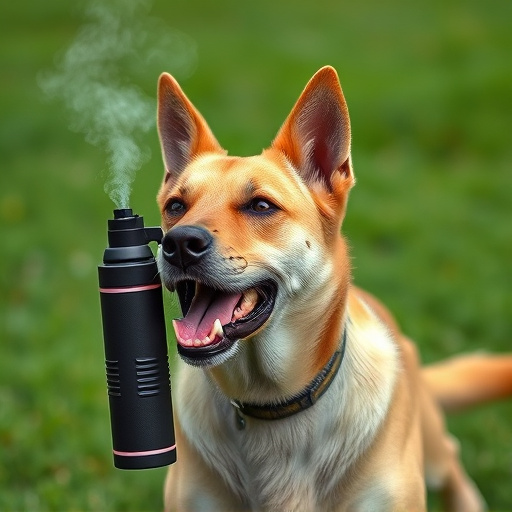Understanding the unique pepper spray formulation is key when confronting aggressive dogs. This non-lethal tool uses capsaicin, a chili pepper ingredient, to temporarily disable and deter hostile behavior while ensuring human safety through carefully balanced components. Essential oils enhance its effectiveness, and specific nozzle designs ensure even application. Desirable features include weather resistance and longevity. Use these pepper sprays responsibly, following local laws, safe handling practices, and manufacturer instructions for optimal effect and to prevent harm to yourself or others.
“Uncover the power of pepper spray as a tool for dog owners facing aggressive encounters. In this comprehensive guide, we explore the science behind Pepper Spray Formulation Against Aggressive Dogs, focusing on understanding its effectiveness. Learn about the key components that make a formula powerful yet safe. Discover the art of application techniques to ensure optimal results. From safety precautions to navigating challenging situations, this article equips you with knowledge to protect yourself and your loved ones from potential dog threats.”
- Understanding Pepper Spray Formulation for Dog Confrontations
- Key Components of an Effective Animal Pepper Spray
- Safety and Application Techniques for Mace Formula Pepper Spray
Understanding Pepper Spray Formulation for Dog Confrontations
When it comes to confronting aggressive dogs, understanding the pepper spray formulation is key. Pepper spray for dog interactions is specifically designed to incapacitate temporarily and deter hostile behavior. The formula typically includes capsaicin, the active ingredient found in chili peppers, which causes a burning sensation and irritation when in contact with eyes, nose, and skin. This non-lethal self-defense tool is particularly useful for pet owners, walkers, and anyone interacting with unpredictable canines.
The mace formula animal pepper spray is crafted to balance potency with safety. It’s crucial that the spray breaks down quickly to minimize environmental impact, ensuring it’s effective only on the targeted dog without harming bystanders or domestic pets. Additionally, the formulation may incorporate UV dissipative agents to ensure the spray dissipates safely in sunlight, reducing residual effects. Knowing these aspects of pepper spray formulation empowers individuals to handle potential dog confrontations more effectively and securely.
Key Components of an Effective Animal Pepper Spray
When creating a pepper spray designed for animal deterrence, especially against aggressive dogs, several key components contribute to its effectiveness. The primary active ingredient is capsaicin, the compound responsible for the heat and irritation associated with chili peppers. This substance disrupts an animal’s sensory perception, temporarily blinding and disorienting them. The formula should balance capsaicin concentration with other additives to ensure safety for humans while maintaining its power against animals.
In addition to capsaicin, a good pepper spray for dogs may incorporate ingredients like essential oils known for their natural repulsive properties against wildlife. These can enhance the spray’s persistence and overall potency. The delivery system is also crucial; a fine mist nozzle allows for even application, ensuring maximum coverage on an animal’s sensitive areas. Moreover, weather resistance and a long shelf life are desirable traits to withstand varying environmental conditions.
Safety and Application Techniques for Mace Formula Pepper Spray
When using mace formula pepper spray, safety is paramount. It’s designed to incapacitate an aggressor temporarily, but it should only be deployed as a last resort when facing an imminent threat from a dog or any other danger. Before carrying and using pepper spray, familiarize yourself with local laws and regulations regarding its possession and use. Always store the spray in a secure location, out of reach of children and unauthorized individuals.
Application techniques vary slightly depending on the type of pepper spray, but generally, you should aim for the face—eyes, nose, and mouth—of the target animal. For aggressive dogs, consider aiming for their legs to trip them momentarily while retreating to safety. Spraying directly into the eyes can cause severe irritation and temporary blindness, giving you valuable time to escape or call for help. Ensure you follow the manufacturer’s instructions for proper usage, including distance recommendations, to maximize effectiveness and minimize cross-contamination.
When it comes to protecting yourself from aggressive dogs, understanding the mace formula animal pepper spray is key. By knowing the active ingredients and their effects, as well as safe application techniques, you can effectively deter canine attacks without causing long-term harm. Remember, the right pepper spray formulation can be a game-changer in potentially dangerous dog confrontations.
